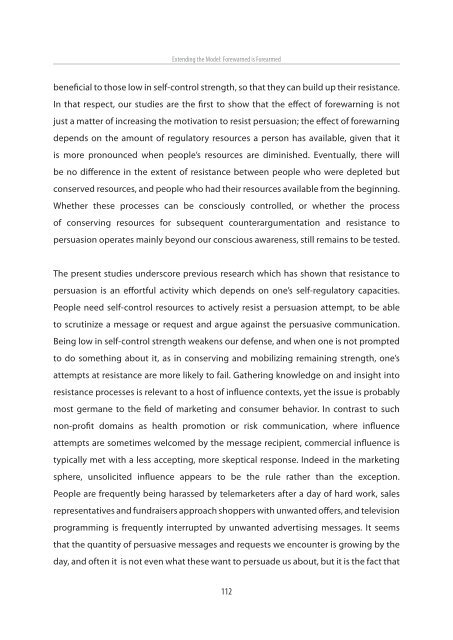Chapter 1 - Universiteit Twente
Chapter 1 - Universiteit Twente
Chapter 1 - Universiteit Twente
Create successful ePaper yourself
Turn your PDF publications into a flip-book with our unique Google optimized e-Paper software.
Extending the Model: Forewarned is Forearmed<br />
beneficial to those low in self-control strength, so that they can build up their resistance.<br />
In that respect, our studies are the first to show that the effect of forewarning is not<br />
just a matter of increasing the motivation to resist persuasion; the effect of forewarning<br />
depends on the amount of regulatory resources a person has available, given that it<br />
is more pronounced when people’s resources are diminished. Eventually, there will<br />
be no difference in the extent of resistance between people who were depleted but<br />
conserved resources, and people who had their resources available from the beginning.<br />
Whether these processes can be consciously controlled, or whether the process<br />
of conserving resources for subsequent counterargumentation and resistance to<br />
persuasion operates mainly beyond our conscious awareness, still remains to be tested.<br />
The present studies underscore previous research which has shown that resistance to<br />
persuasion is an effortful activity which depends on one’s self-regulatory capacities.<br />
People need self-control resources to actively resist a persuasion attempt, to be able<br />
to scrutinize a message or request and argue against the persuasive communication.<br />
Being low in self-control strength weakens our defense, and when one is not prompted<br />
to do something about it, as in conserving and mobilizing remaining strength, one’s<br />
attempts at resistance are more likely to fail. Gathering knowledge on and insight into<br />
resistance processes is relevant to a host of influence contexts, yet the issue is probably<br />
most germane to the field of marketing and consumer behavior. In contrast to such<br />
non-profit domains as health promotion or risk communication, where influence<br />
attempts are sometimes welcomed by the message recipient, commercial influence is<br />
typically met with a less accepting, more skeptical response. Indeed in the marketing<br />
sphere, unsolicited influence appears to be the rule rather than the exception.<br />
People are frequently being harassed by telemarketers after a day of hard work, sales<br />
representatives and fundraisers approach shoppers with unwanted offers, and television<br />
programming is frequently interrupted by unwanted advertising messages. It seems<br />
that the quantity of persuasive messages and requests we encounter is growing by the<br />
day, and often it is not even what these want to persuade us about, but it is the fact that<br />
112
















